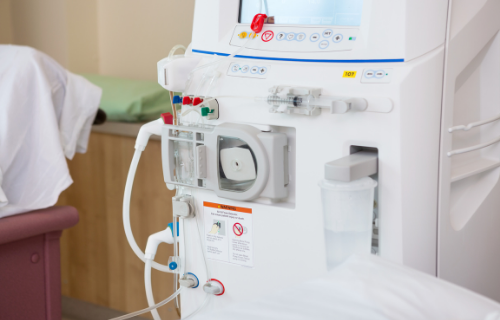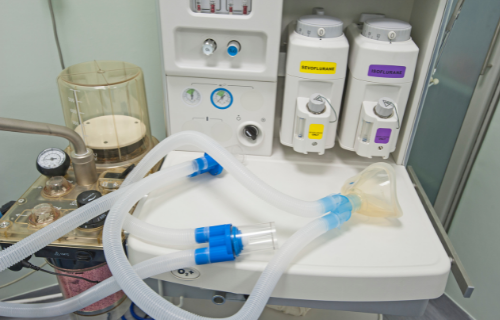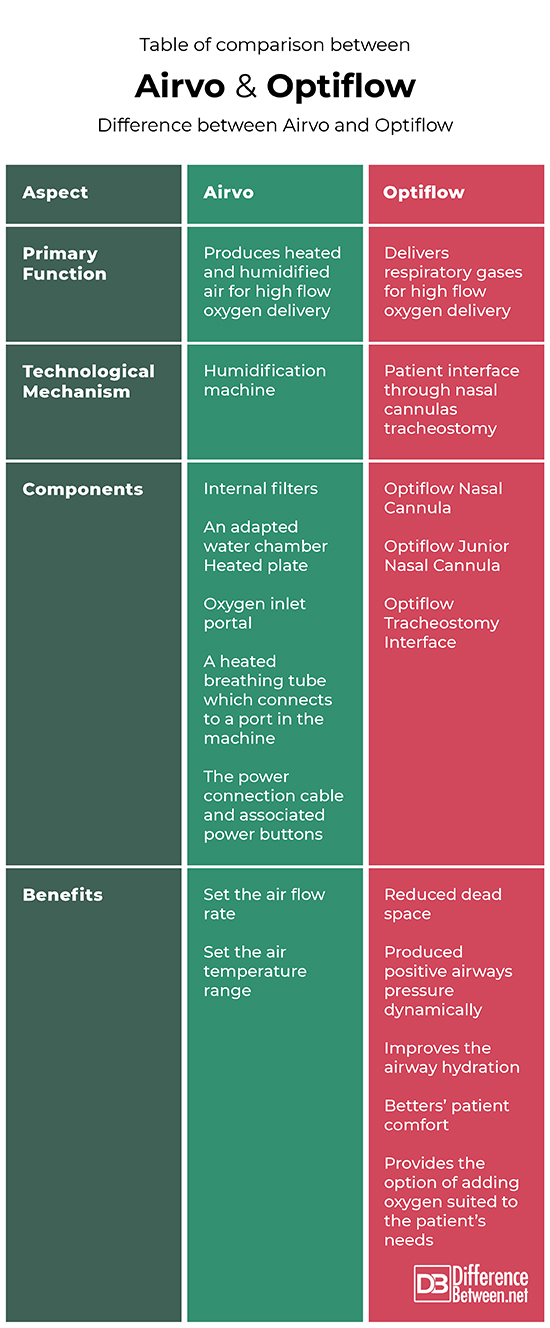Difference Between Airvo and Optiflow

Introduction
When patients suffer from an organ disfunction, resorting to oxygen therapy is usually first in line. In stable patients, a nasal cannula delivering low-flow oxygen is most often used. For critical patients and patients in intensive care (mostly unstable), high-flow oxygen is commonly delivered via nasal cannula.
When high-flow oxygen is heated and humified, oxygenation levels in patients seem to improve as a function of flow demand and airway pressures. The delivery of this heated and humified high-flow oxygen can be done with an Airvo system (without Optiflow interface), an Optiflow system (without Airvo humidification machinery) or using Optiflow interfaces with an Airvo device.
Airvo and Optiflow offer unique benefits which have made strides in the progress of respiratory treatments for adults and children by bettering the therapy for both patients and the caregivers of patients.

This article aims to delve into both types of systems and take a closer look at the differences.
What is Airvo and Optiflow?
Airvo is a product manufactured by Fisher & Paykel. It is defined as a type of humidifier mechanism that produces heated (or warmed) and humidified oxygen. The Airvo device is compatible with numerous types of interfaces for respiratory gas delivery. This includes Optiflow (nasal cannula), Oxygen masks (with an adaptor) and Tracheostomy (either with a mask adaptor or without).
Optiflow is a product also manufactured by Fisher & Paykel. Optiflow is a type of mechanism designed for high flow nasal high flow therapy. This includes nasal cannulas and an interface with tracheostomies.
Mechanism of Action
Airvo has been designed as a humification technology to produce high flows of respiratory air for delivery via Optiflow interfaces or others. The Airvo systems can control the flow rate of air as well as control the temperature of the humified air delivered.
Airvo systems comprise the following:
- The Airvo machine with appropriate internal filters
- An adapted water chamber for the humidification process on a heated plate
- An oxygen inlet portal
- A heated breathing tube which connects to a port in the machine
- The power connection cable and associated power buttons
Optiflow is the interface section of the humified breathing system for high flow oxygen delivery. The way the Optiflow works is through the following:
- The interface designs reduce dead space by clearing the upper airway, by lowering the rebreathing of carbon dioxide by patients and by improving ventilation that takes place in the alveola
- By providing a positive airway pressure dynamically through the slowing of breathing and improving ventilation that takes place in the alveola
- The technology hydrates the airways by protecting the epithelium found along the airways, and improving the clearing of mucus
- Improves patient comfort by lowering the load of work for nursing staff and provides a less invasive form of oxygen delivery. Patients also have the ability to interact with others and eat or drink, as well as sleep
- The technology offers a supplementary supply of oxygen to patients when required, meaning that there is the option of meeting all breathing air needs of a patient
Technological Compatibilities
Airvo machinery is ideally used with Optiflow interfaces. Airvo can be used with nasal cannulas, tracheostomies and can also be used in combination with vented masks.
Optiflow interfaces can be used with Airvo machines or other humidifiers. However, studies showed that when Optiflow interface was used with a MR850 device, the humidity was less than with Airvo machinery.
Table of comparison between Airvo and Optiflow

Summary
Airvo machinery is ideal for the delivery for humidified high flow nasal oxygen delivery. Results show that when used with Optiflow interfaces, the results are most effective. Optiflow interfaces can be used as independent Optiflow systems, for example when coupled with a MR850 humidifier. However, the results show less ideal humidity results than when used with Airvo machinery.
Airvo machines can accommodate nasal cannula, tracheostomies, and vented masks. Optiflow takes form as nasal cannula or an interface with tracheostomies.
Airvo offers the benefits of controlling the temperatures and flow rates of humidified air. Optiflow interfaces, on the other hand, offer benefits such as improved airway functions and better experiences for the patient. Optiflow also has the added benefit that allows the patient to be physically mobile while receiving therapy instead of being bed bound and unable to speak.
In summary, Airvo and Optiflow are both used for the delivery of high flow respiratory air in patients. Where Airvo is typically the mechanical component heating and humifying the air, Optiflow is typically the interface component for the actual delivery of the air. Although both are compatible with other technologies, they are best designed when used with each other.
FAQ
What is the difference between high flow nasal cannula and Optiflow?
Optiflow is a type of high flow nasal oxygen through the form of a nasal cannula but provides humified oxygen. Therefore, the difference is in the humidity in the oxygen provided via cannula in normal nasal prongs and Optiflow nasal cannula.
What does the Airvo machine do?
The Airvo machine is a device which delivers humified oxygen via Optiflow nasal cannulas, a typical vented oxygen mask, or an adapted or original tracheostomy method.
What type of ventilation is Airvo?
Airvo is a technology designed for the delivery of high flow oxygen therapy by Optiflow. The type of ventilation offered is therefore humidified high flow oxygen therapy where the temperature of the air can be controlled as well as the flow rate.
- Difference Between a Cochlear Implant and Normal Hearing - October 4, 2022
- Difference Between Obstructive and Restrictive Spirometry - September 11, 2022
- The Difference Between White Box and Black Box Testing - September 11, 2022
Search DifferenceBetween.net :
Leave a Response
References :
[0]Chikata, Yusuke., Izawa, Masayo., Okuda, Nao., Itagaki, Taiga., Nakataki, Emiko., Onodera, Mutsuo., Imanaka, Hideaki. & Nishimura, Masaji. “Humidification Performance of Two High-Flow Nasal Cannula Devices: A Bench Study”. Respiratory Care, vol. 59, no. 8, 2014, pp. 1186-1190
[1]Fisher & Paykel Healthcare. “Optiflow Nasal High Flow”. https://www.fphcare.com/us/hospital/adult-respiratory/optiflow/airvo-2-system/
[2]New Jersey Respiratory Associates. “AIRVO by Fisher & Paykel”. https://www.seenjra.com/airvo#:~:text=The%20AIRVO%20is%20a%20humidifier,Indications%20for%20Use
[3]Paediatric Innovation, Education & Research Network. “WESSEX PCCN Guidelines for The Use of Nasal Humidified High Flow Oxygen in Children”. Nasal Humidified High Flow Oxygen. https://www.piernetwork.org/uploads/4/7/8/1/47810883/nasal-humidified-high-flow-oxygen-full-text.pdf
